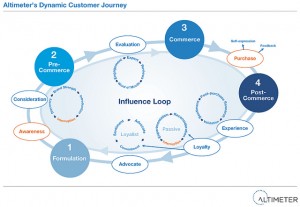The sales funnel: It’s a simple, elegant metaphor for a customer’s journey. To this day, companies allocate resources based on that 1898 visual metaphor. Only customers don’t buy that way anymore. Not B2B or B2C.
Advertising advocate Elias St. Elmo Lewis is credited with mapping the magical customer journey from awareness and interest to desire and action. Pre-web. Pre-social media. Pre-television. Even pre-widespread literacy.
The traditional funnel misses the need to take care of the customer after the sale. Today’, the social impact that a single customer can have on a brand can be significant. If the message resonates, it spreads. In extreme cases, disgruntled customers have used paid content to reach the largest possible audience and create the biggest impact to a company. It is not unusual to see the majority of a company’s negative social sentiment coming from bad customer experiences. These are what prospects see when they are forming their opinion of a new “prospect company”.
 Altimeter Group reinvented the Dynamic Customer Journey in 2012. It is a cycle, not a funnel, and adds “interruptions” that often occur in social media. It underscores the that customer experience at every touch point is vital. Brian Solis, when sharing on the AT&T small business blog in 2012 [no longer available on the site] explained that “touch points open and close whether a customer stands on the stage of awareness, consideration, purchase, or post purchase. It is in those moments that engagement, regardless of source or shape, affects the next steps and impressions of customers.”
Altimeter Group reinvented the Dynamic Customer Journey in 2012. It is a cycle, not a funnel, and adds “interruptions” that often occur in social media. It underscores the that customer experience at every touch point is vital. Brian Solis, when sharing on the AT&T small business blog in 2012 [no longer available on the site] explained that “touch points open and close whether a customer stands on the stage of awareness, consideration, purchase, or post purchase. It is in those moments that engagement, regardless of source or shape, affects the next steps and impressions of customers.”
In a June, 2016 Forbes article, Solis shares research that “a whopping 89% of customers say they have switched brands because of poor customer experience (CX).” Ouch.
When I teach about social media or economy of “connected consumers”, to borrow a term from Solis, the Altimeter Dynamic Customer Journey is still one of my most effective tools. It shows the obvious – buying has changed, and that the ability to measure the realities of each touch point is both possible and critical.
Taking the next step to properly analyze the data and keep what works and improve what is failing. This appears to be the hardest thing for many companies to do.


